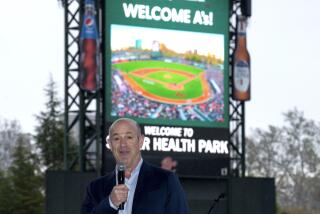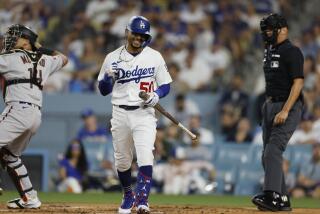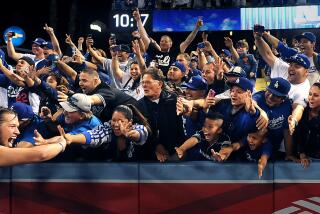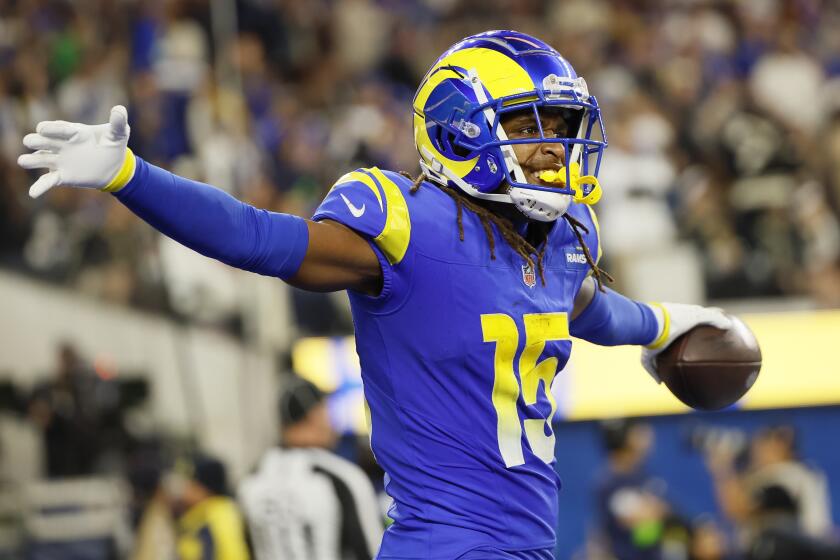Playoff Teams Face Cold Reality
OAKLAND — Oakland Athletic left-hander Barry Zito will have a wealth of experience to draw on should he find himself on the mound during a bone-chilling October night in Cleveland, a cold and clammy October evening in Seattle or a frigid November night in St. Louis.
No matter how wintry the weather gets this postseason, it will be tough to top that early April day in 1999, when Zito, then a USC junior, pitched against Washington State in Pullman, Wash., where a temperature of 27 degrees, a wind-chill factor of eight degrees and a snow storm produced blizzard-like conditions.
Scrambling for protection, USC players purchased Washington State wool beanies from the campus bookstore, pulled them over their faces, cut eye and mouth holes so they could see and breathe, and wore them under their caps for the game. Zito threw a 150-pitch complete game to lead USC to a 5-3 victory.
“If I can pitch well in those conditions,” Zito said, “I can pitch well anywhere.”
He might have another chance to soon. With the playoffs pushed back a week because of the Sept. 11 terrorist attacks and the World Series likely to stretch into November, there could be some serious teeth-chattering in the next three weeks.
Baseball caught a break with warm-weather Arizona, Houston and Atlanta reaching the National League playoffs, but the weather in St. Louis can be harsh this time of year. In fact, the start of Game 4 in the Arizona-St. Louis division series Saturday was delayed 31/2 hours by rain.
Weather shouldn’t be a factor in Oakland, where the A’s, leading two games to one, will try again today to clinch their American League division series against the Yankees. But even with a roof, Seattle’s Safeco Field can be extremely cold and damp, as it was during Wednesday’s off-day workout between Games 1 and 2 of the AL division series between the Mariners and Indians.
And then there’s New York and Cleveland. If the Indians--who lead the Mariners, two games to one, with Game 4 today in Cleveland--or the Yankees advance to the AL championship series, scheduled from Oct. 17-25, or the World Series, scheduled for Oct. 27-Nov. 4, break out the long johns, parkas and mittens.
The National Weather Service has predicted cooler than normal temperatures across much of the nation this fall, but normal conditions in Cleveland and New York in October and early November can be extreme for baseball.
Who could forget Game 4 of the 1997 World Series in Cleveland, when the Indians and Florida Marlins started with a game-time temperature of 38 degrees, the lowest on record for a World Series game, and a wind-chill factor of 18 degrees? There were also light snow flurries throughout, and Christmas carols rang from the Jacobs Field public address system during batting practice.
That game was played on Oct. 22.
In Game 3 of that World Series, played on Oct. 21, the wind-chill factor dipped to 23 degrees by the end of a 4-hour 12-minute marathon in which the Marlins and Indians combined for 25 runs, 17 walks and six errors. After Florida’s 14-11 victory, then-Cleveland Manager Mike Hargrove said, “Both teams out-uglied each other.”
Hitting can be difficult in such conditions. The sting from a jam shot can hurt a batter’s hands for an inning or two. Standing on the field for a long half-inning can send a player into a cryogenic state, and keeping your throwing hand warm is always a challenge. But pitchers, especially relievers, seem most affected by such weather.
“It’s terrible for hitters, but it’s more detrimental for relief pitchers,” Oakland left-hander Mike Magnante said. “Once a starter warms up and gets loose, he’s usually OK. For a relief pitcher to come in from the dead cold can be difficult.”
Zito,who pitched well but took the loss Saturday in the Yankees’ 1-0 win at Oakland, actually looks forward to it.
“I like pitching in cold weather,” Zito said. “You just can’t let external things affect your belief in yourself.”
More to Read
Go beyond the scoreboard
Get the latest on L.A.'s teams in the daily Sports Report newsletter.
You may occasionally receive promotional content from the Los Angeles Times.











